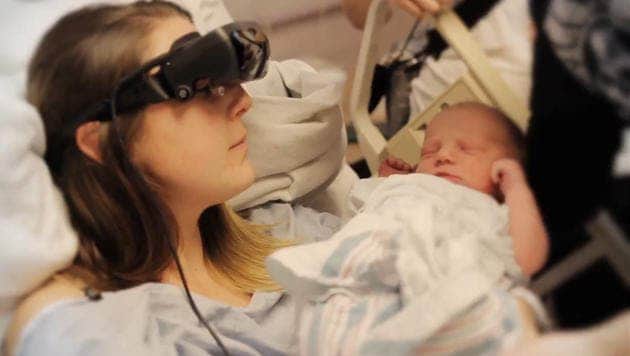What is it like to see for the first time? Most of us can’t even imagine that, because it happened when we were babies and we can’t recall our first visual memories. But Kathy Bleitz, a Canadian woman, certainly will – for the first time, she was able to see using a new technology called eSight. The first thing she saw was her baby.
Bleitz has been living with Stargardt disease, an inherited degenerative disease of the retina that causes progressive vision loss usually to the point of legal blindness. Legal blindness is a term used when people aren’t absolutely blind, but their eyesight is so bad that for all practical purpose, they can be considered blind (can’t really see people, can’t navigate by themselves, etc). For Bleitz, eyesight is extremely fuzzy – she can just see wavy shapes in broad daylight, and it gets even worse in dim light.
However, just after she gave birth, Bleitz got some very good news – she got access to the new eSight headset; eSight is a new patented technology – basically wearable electronic glasses that empower the legally blind to actually see. According to their website, eSight works for most people that are legally blind and is approved by the FDA. Inside the headset, there’s a high-definition camera, organic light-emitting diode (OLED) screen and a range of other technologies which capture images in real time and then transform and augment the image. It allows the user to adjust the contrast, brightness and color, just like with a television. It can also magnify the image up to 14 times.
“Interestingly, eSight’s many unique features – such as 14-times zoom, image contrast enhancement, reverse colour display, etc. – enable eSight users to actually see many things that normally-sighted people cannot see,” the developers write on their website.
The device shows great promise for most people suffering from blindness. In fact, most people we call blind aren’t fully blind – approximately 95 percent of legally blind individuals still have some eyesight and can be helped by eSight. A pair goes for quite a big price ($15,000) but developers have set up a donation system to help people acquire a pair. Tech Times reports that so far 140 people around North America are using them, and the company is now working on improving the design – making it smaller and easier to use.
Here’s another video of American airforce veteran, Mark Cornell, see for the first time in 20 years:




